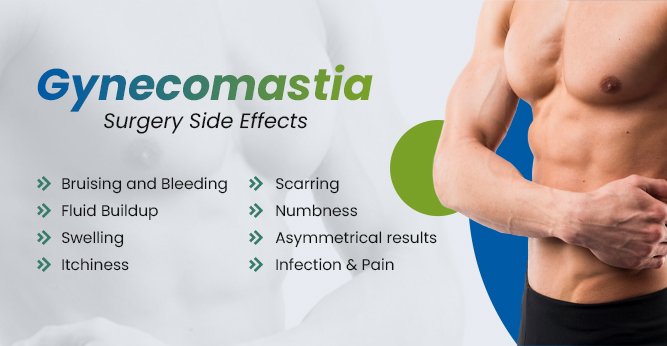
Gynecomastia or male chest enlargement has been a growing concern among men throughout the world. According to studies, approximately 65% of boys and men around the world are affected by gynecomastia. The condition is typically a result of hormonal imbalances, which can significantly impact self-esteem and quality of life.
While male chest reduction surgery or gynecomastia surgery is the most effective solution for this condition, it is crucial to understand the side effects before considering the procedure. In this blog post, we have shared a complete list of potential side effects of gynecomastia surgery and what you can expect during recovery. Read on for more!
Is Male Gynecomastia Surgery Safe?
Male breast reduction surgery is generally safe when performed by a skilled and certified plastic surgeon in a hygienic facility. During the procedure, surgeons remove excess breast tissue and, in some cases, skin to correct enlarged male breasts.
Although gynecomastia surgery is highly successful in most cases, it comes with certain risks and side effects. Being informed about potential gynecomastia surgery side effects can help you make a well-rounded decision and prepare for the postoperative period.
Read More: Gynecomastia 101: Recognizing and Treating Male Breast Enlargement
Gynecomastia Surgery Side Effects

Side effects are rare after gynecomastia surgery when it is done by a certified gynecomastia surgeon like Dr. Sidharth Sakhiya at Celebre Aesthetics in Surat. However, in some cases, patients may experience the following issues which are usually treatable with expert guidance:
Bruising and Bleeding
Bruising and bleeding are common gynecomastia surgery side effects. After the procedure, you may see bruising around the chest area, which typically resolves within a few weeks.
However, if you see excessive bleeding, you should immediately consult your plastic surgeon. To minimize the risk of bleeding, Dr. Sidharth Sakhiya advises patients to avoid blood thinners such as aspirin or vitamin E for at least ten days before surgery.
Read More: Causes of Gynecomastia: Why Do Men Develop Enlarged Breasts?
Fluid Buildup
Fluid buildup, or seroma, is another common side effect of gynecomastia surgery. It happens when fluid accumulates in empty spaces created by the removal of breast tissue.
Although fluid buildup is a normal part of healing, excessive fluid is problematic. Surgeons usually use drains to collect and remove excess fluid within a few days post-surgery. They may also instruct you to wear a compression garment to help reduce fluid accumulation and support speedy healing.
Swelling
Swelling is a natural response to surgery and can affect the chest area for a few days. It usually peaks within the first few days and gradually subsides over the next few weeks.
To manage swelling, avoid strenuous activities and heavy lifting. Instead, use cold packs and wear the compression vest as prescribed. If swelling persists or is accompanied by severe pain, consult your surgeon immediately to rule out potential complications.
Itchiness
As the skin heals, most of the patients experience itchiness around the surgical site. This is a normal part of the healing process but can be uncomfortable.
Avoid scratching the area to prevent irritation or infection. You can use over-the-counter hydrocortisone cream to help alleviate itchiness, but we would highly recommend consulting your surgeon before applying any topical treatments.
Scarring
Scarring is an inevitable part of any surgical procedure, including gynecomastia surgery. However, in the case of gynecomastia surgery, scars typically fade in a very short span of time.
To minimize scarring, follow your surgeon’s aftercare instructions strictly. Avoid sun exposure and consider using scar-reducing products as prescribed by your surgeon. Most scars blend with the natural color of the areola, but if you’re prone to hypertrophic or keloid scarring, discuss this with your surgeon beforehand.
Numbness
Temporary numbness in the chest area, including around the nipples, is one of the most common gynecomastia surgery side effects. This occurs due to nerve disruption during the procedure.
In most cases, the sensation gradually returns within a few days or weeks. However, if numbness persists for a few months, consult your surgeon for further evaluation.
Asymmetrical Results
Post-surgery asymmetry, where the breasts may appear uneven in size or shape, is another complication that most patients report. It is important to understand that two breasts or nipples are never identical and their natural appearance usually varies in size and shape. That’s why the same issue persists even after surgery.
To avoid significant asymmetrical results, consult an experienced gynecomastia surgeon.
Infection & Pain
Although rare, infection is a serious concern with any surgical procedure. Signs of infection include redness, warmth, swelling, and pus at the incision site, along with fever and increased pain.
Consult a gynecomastia surgeon who performs the surgery in a sterile, hygienic environment with world-class equipment to reduce the risk of infection. Celebre Aesthetic has a state-of-the-art facility where we prioritize hygiene to ensure the best possible care for our patients.
In addition, patients need to follow all aftercare instructions to reduce infection risk. Contact your surgeon if you notice any signs of infection or if the pain becomes severe or unmanageable.
Read More: Chest Enlargement in Men: Recognizing and Treating Gynecomastia Symptoms
Recovery Timeline after Gynecomastia Surgery
Recovery after gynecomastia surgery varies from person to person, depending on their body strength and underlying health conditions. Although full recovery can take a few weeks, you can expect to return to work and light activities within 2-3 days, sometimes even immediately.
Post-surgery swelling and bruising usually resolve within the first 24-48 hours. For strenuous activities, including weightlifting, wait for 6-8 weeks or until your surgeon provides clearance.
Is There an Alternative to Surgery for Gynecomastia?
Currently, surgery remains the most effective treatment for advanced stages of gynecomastia, particularly when the condition involves significant tissue development and excess skin. While diet and exercise can help with mild cases, they are not effective for most cases. If you have gynecomastia that hasn’t improved with non-surgical methods, surgery is your best option. Consult with Dr. Sidharth Sakhiya, a certified gynecomastia specialist, to explore all available treatment options.
Why Should You Consult a Certified Gynecomastia Plastic Surgeon?
Consulting a certified and experienced plastic surgeon is essential for achieving the best outcomes in gynecomastia surgery. A qualified surgeon will assess your condition, discuss potential risks and benefits, and tailor the procedure to meet your specific needs. Choosing a skilled professional reduces the likelihood of complications and ensures a higher chance of achieving the desired results.
At Celebre Aesthetics, we specialize in male breast reduction, offering personalized care and cutting-edge techniques to address your unique needs. Under the guidance of Dr. Sidharth Sakhiya, a renowned, board-certified plastic surgeon in Surat, we prioritize your safety, comfort, and satisfaction throughout your surgical journey. We have world-class surgical equipment and a state-of-the-art facility to reduce the risk of gynecomastia surgery side effects and ensure the best possible results. Contact us today to schedule a consultation now!



